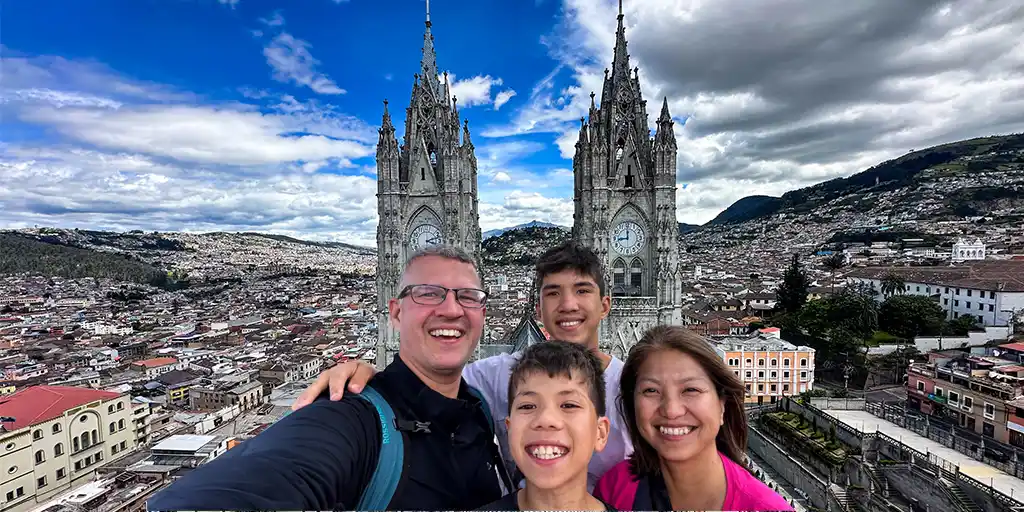Discover the Ecuadorian Amazon with kids at La Selva Lodge. A family adventure deep in the rainforest with wildlife, culture, and unforgettable experiences
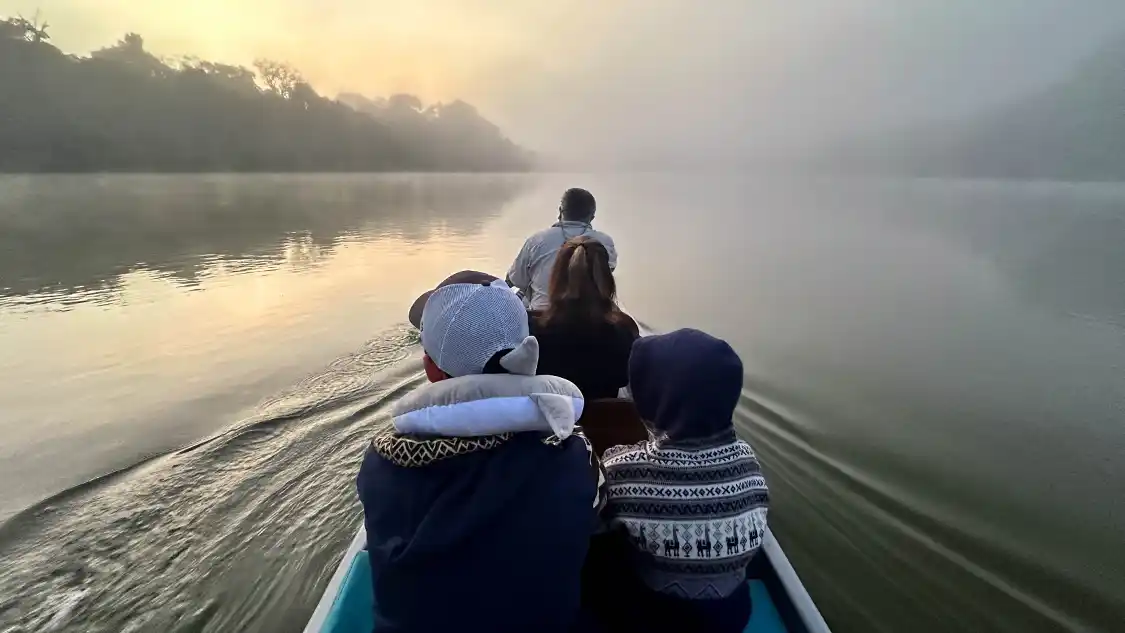
Two unforgettable weeks. That’s what we had to explore the wonders of Ecuador — strolling the narrow hills of Quito’s colonial neighborhoods to hiking to the base of Quilotoa Crater. And in the middle of it all, a week-long cruise through the magic of the Galápagos Islands — for most, that would be a lot. But my family had one last Ecuadorian travel adventure ahead: the Ecuadorian Amazon.
This journey into the depths of the world’s most famous rainforest would be the final stop on our Ecuador itinerary. We transited from Isabella Island, back to Quito, said goodbye to Christina’s mother, who joined us for our cruise in the Galápagos, and boarded an early morning flight to the edge of the world — the Amazon Basin.
From the airplane window, the jungle looked endless. Towering mountain peaks gave way to a vast green expanse, coffee-colored rivers snaking through the trees like a barista’s nightmare. It was hypnotic — and humbling.
After decades of travel around the world, there are few places left that still feel truly wild. The Amazon Rainforest is different. It doesn’t just look untamed — it is untamed.
Coca: The Gateway to the Ecuadorian Amazon

Our plane touched down in Puerto Francisco de Orellana, or as it’s known locally, Coca. This small but vital town sits at the edge of the Napo River and is considered to be the gateway to the Ecuadorian Amazon — the last real connection to civilization before the dense jungle swallows the map.
Coca is a gritty, humid, and non-stop town. Worn-down pickup trucks share the road with motorbikes, oil workers munch on empanadas beside fruit vendors, and the air is filled with the smells of diesel, river mud, and fried plantains. From the main street, you can see barges hauling supplies upriver and longboats packed with travelers heading down toward Yasuní National Park.
This isn’t the romanticized Amazon of storybooks — it’s blue-collar Ecuador. Life here beats to the rhythm of the Napo River. For travelers, it’s a mandatory stop — a place to adjust, grab last-minute essentials, and get one last taste of the modern world before trading it for the sounds of cicadas and howler monkeys.
Our family spent a few hours here between flights and transfers. Cohen and Dylan chased lizards along the docks, Christina hunted down a bottle of industrial-strength bug spray, and I soaked in the fact that in a few hours, we’d be out of range — no cell service, no Wi-Fi, no notifications. Just us, the jungle, and whatever waited for us downriver.
Getting to La Selva Lodge

At the La Selva Lodge office, the La Selva Lodge crew greeted us on the upcoming trip down the Rio Napo. Our bags were packed into the back of a long, motorized canoe, and we quickly followed suit.
We booked our stay at La Selva Lodge directly through their website, but you can also find it listed on trusted platforms like Booking.com and Expedia. Availability tends to disappear quickly, especially in high season, so it’s worth locking in your dates early.
We quickly hit breakneck speed, tearing down the Rio Napo for two hours. The ride was an eye-opener. The Rio Napo, wide and powerful, carried us east toward the Peruvian border. Along the way, we passed oil rigs and small Indigenous villages where women washed clothes in the fast-moving water while children splashed beside them. At one bend, flames flickered from metal pipes where gas was being burned off — a stark reminder that even here, in the Amazon Rainforest, the modern world is constantly pressing in.
Finally, we reached a small wooden dock jutting from the edge of the riverbank. The air was thick and heavy, a humidity that even made breathing tough. Tiny squirrel monkeys darted through nearby palm trees, quick as shadows, too fast for me to photograph.
Here, we grabbed our gear and transferred to small canoes. Powered by our guide Miguel, we began a 30-minute paddle along a narrow creek — the final stretch of water to Garzacocha Lagoon. It was here, with the sounds of the jungle broken only by the gentle splash of our paddles, that the Amazon Rainforest began to show its true nature.
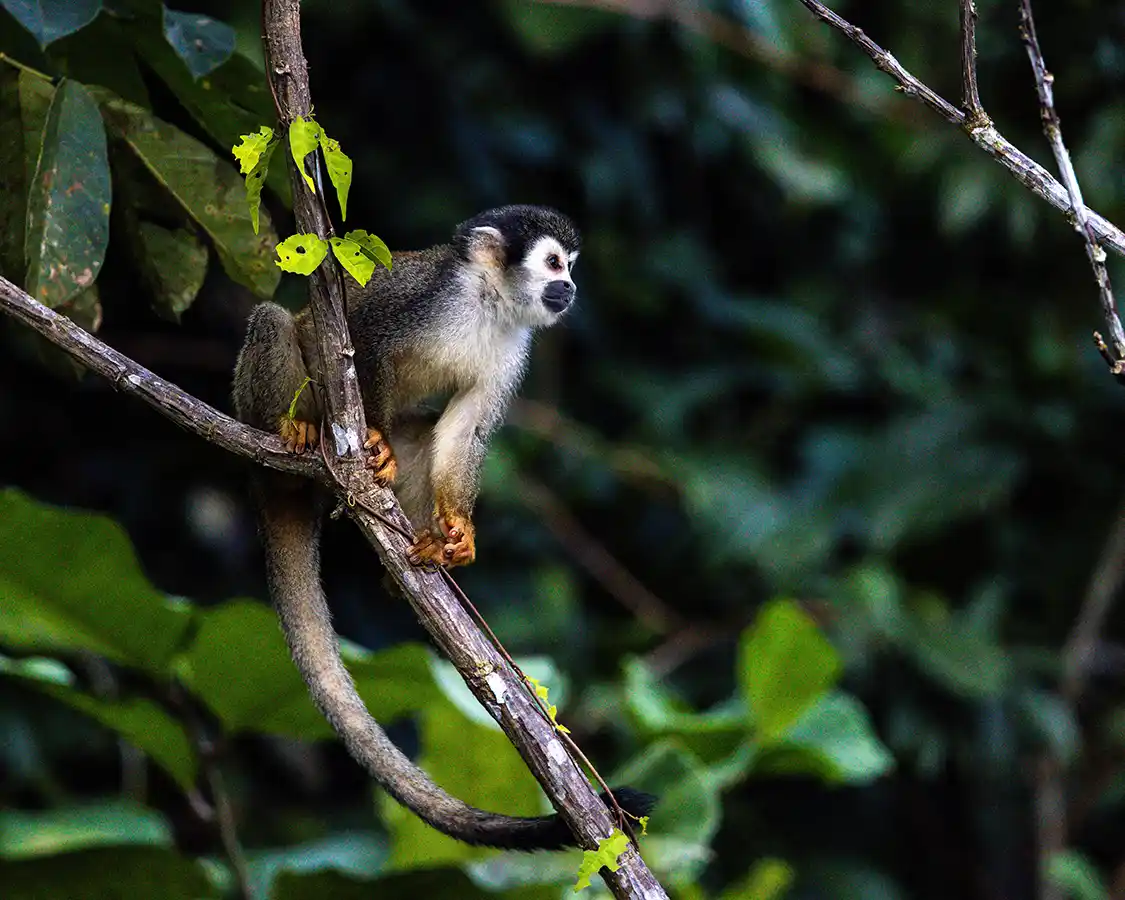

Hoatzins, wild, prehistoric-looking birds with spiky crests, rustled in the branches alongside the river. Howler monkeys bellowed from the far shadows, out of sight, but ever-present. Miguel laughed and called the hoatzins “stinky chickens,” explaining that their odd digestive system gives them an unforgettable, unappealing aroma.
As the narrow channel opened into a mirror-still lagoon surrounded on all sides by dense jungle, all four of us were filled with quiet awe. That feeling that hits when you’ve traveled so far off the map that the world you thought you knew seems too far away to touch.
La Selva Lodge came into view — proof that even in the middle of the Amazon, someone figured out how to build a boutique hotel.
Accommodations at La Selva Eco Lodge
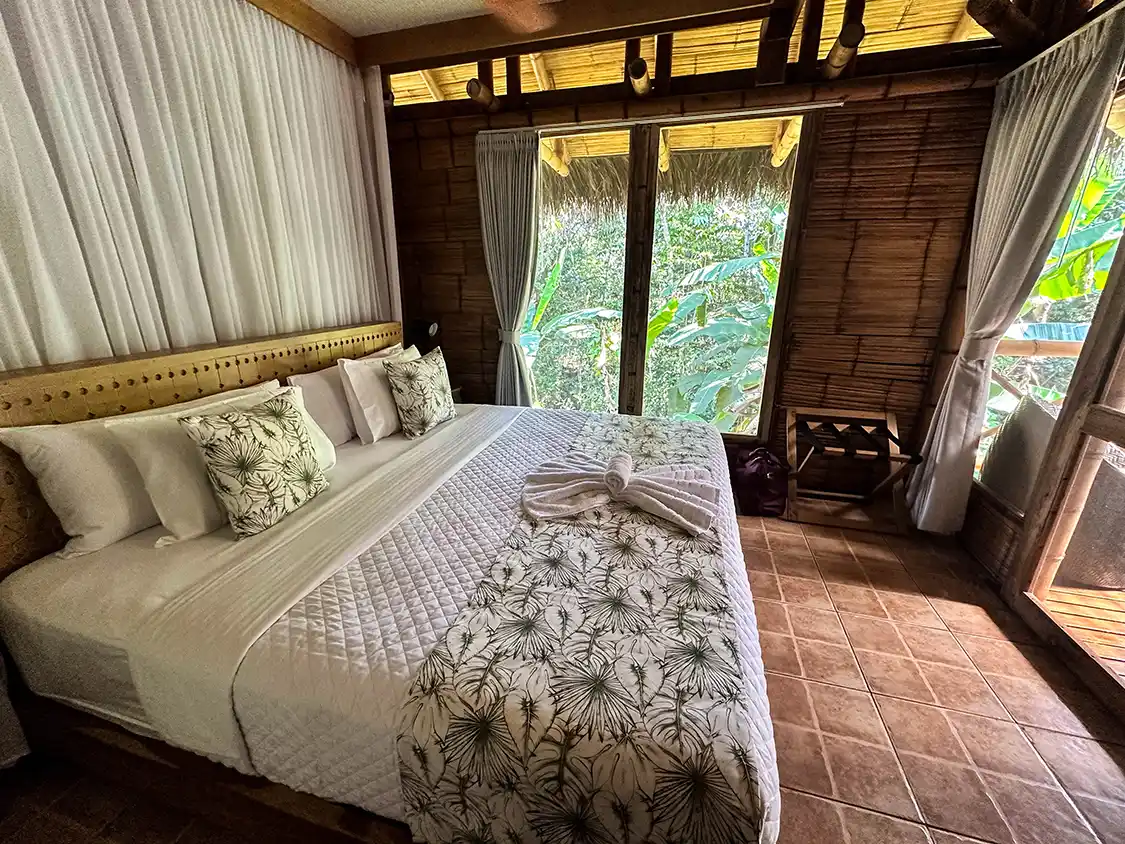
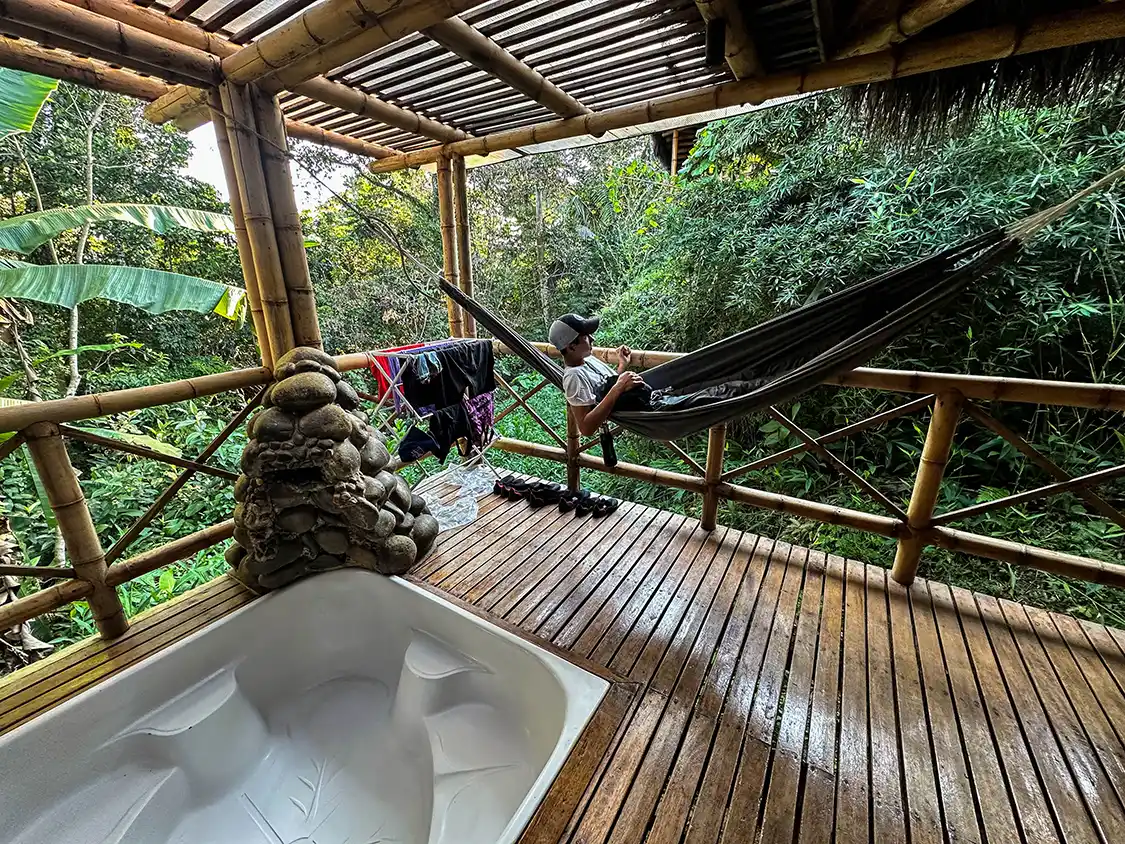
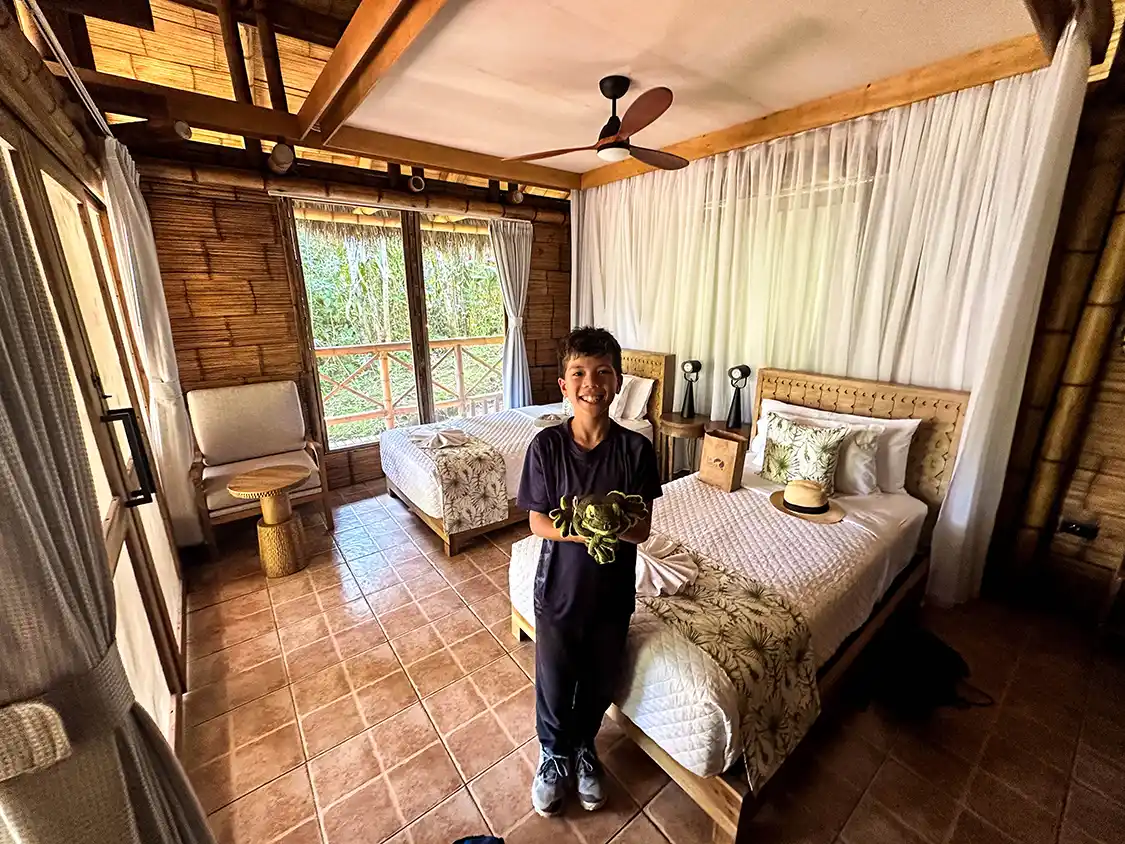
The lodge rose above the rainforest. But as much as the three-story building stood out from the landscape, it also dissolved into it. Around us, the smells of damp earth and wildflowers filled the air. Unseen, a steady drone of Cicadas filled our ears. And then there was the sound that got Cohen excited. The loud smack of a monstrous Arapaina breaching in the lagoon.
The staff at La Selva Lodge greeted us with cool towels and a glass of juice, then led us to an open-air lobby. La Selva Eco Lodge hits an important tourism niche in volatile countries like Ecuador. Evidence that sustainability and comfort don’t need to exist at polarizing ends of the travel spectrum. Nearly everything on the property is built from locally-sourced materials and is powered by solar energy. It feels less like a hotel room and more like a retreat.
We were ushered to a two-bedroom family cabin that sat within the forest canopy. The hut was raised on stilts to keep it out of reach of the seasonal floods. Inside, we had everything that we could need. Mosquito-netting around the beds, locally woven tapestries on the walls, and a gift of a stuffed toy frog for Dylan.
The bathroom was generous, with double sinks, a rain shower, and eco-friendly toiletries. Outside, a wide deck overlooked the jungle and offered just enough comfort to make it feel like home. A soaking tub and a hammock that quickly became Dylan’s favorite reading spot.
Food at La Selva Lodge | Dining in the Amazon Rainforest
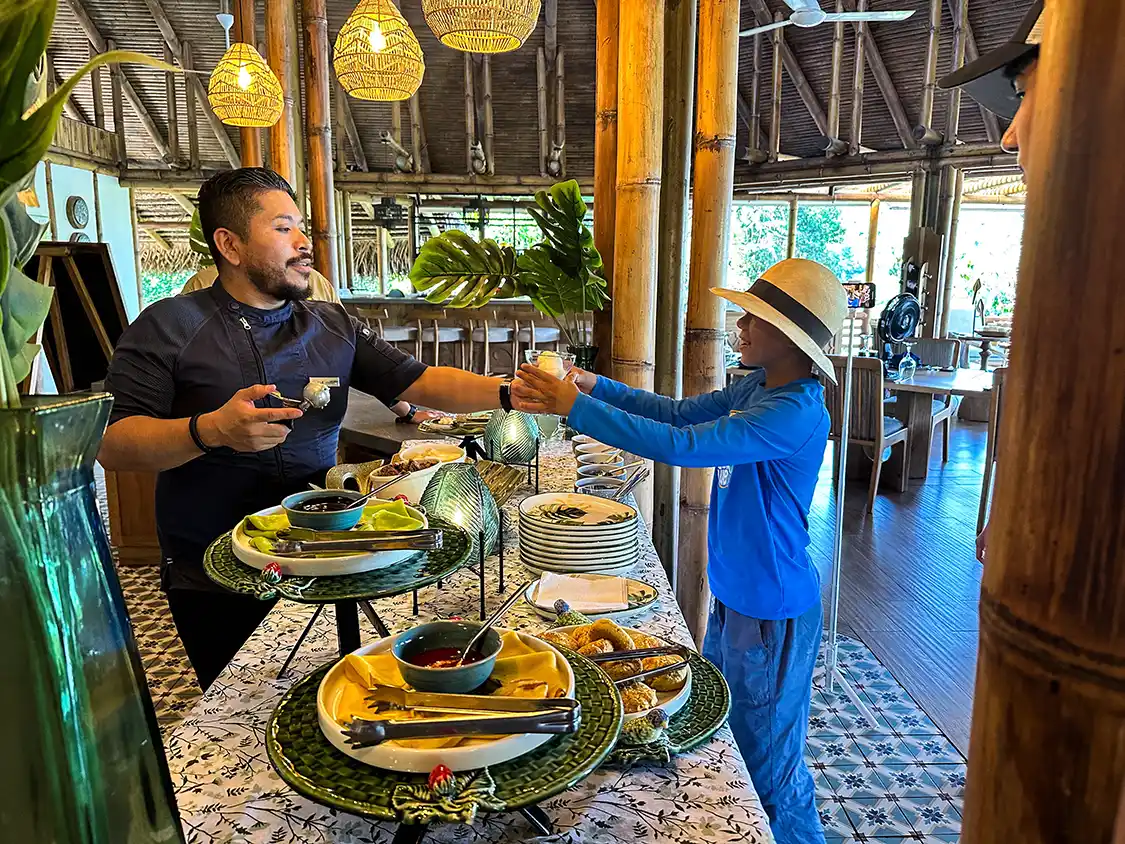
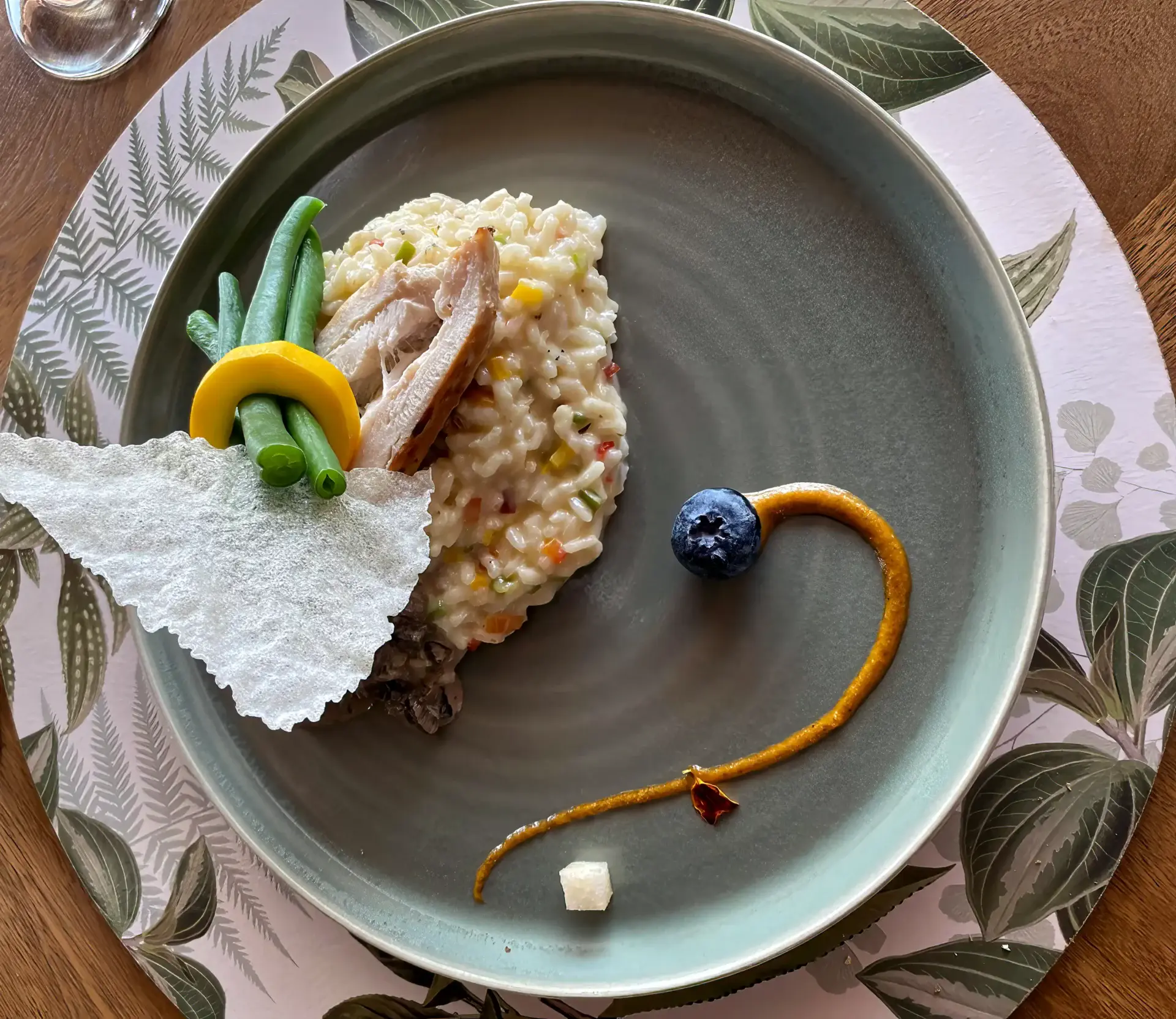

Deep in the Amazon Rainforest, the last thing that my family expected was fine dining. Cohen, who inspects each meal like it’s being voted on by Top Chef Canada, was blown away. After each day spent deep in nature, we’d wander down to the main lodge. With an open-air dining area and lounge that offered panoramic views of Garzacocha Lagoon, it was the best seat in the house.
The food at La Selva Lodge was far beyond anything that we expected. Each plate would have been right at home in a Michelin-star restaurant. One night, we were dining on grilled Amazonian catfish over creamy yuca purée with a drizzle of passionfruit reduction. Another was quinoa risotto topped with local mushrooms and always a sprinkle of gold leaf.
The chef’s obsession with the shiny foil became a running family joke. Every dish, no matter how rustic or elegant, seemed to come with a twist of gold. Christina called it “jungle bling.” Dylan, on the other hand, just wanted to know if it was edible.
Breakfasts were equally delicious: fresh tropical juices, coffee from the Andean foothills, homemade pastries, and platters of fruit that Dylan couldn’t get enough of. Lunches were casual. Pizza, sandwiches, and ice cream sundaes. A pretty decent combination that satisfied all four of us.
As someone who’s eaten my way across continents, from roadside grills in Morocco to Michelin-starred tables in Dubai, I didn’t expect the Amazon rainforest to deliver one of the most memorable meals of our Ecuador trip. But that’s what travel does when it’s at its best — it rewrites your expectations.
Things to Do at La Selva Lodge
During our three days at La Selva Lodge, there were no two days that were the same. Each morning started early, usually around sunrise. The air then was still cool, and the wildlife snapped us awake like a living orchestra. The lodge staff laid out coffee and snacks for morning hikes or paddles, and Migues was always waiting at the dock with a look that seemed to say, “Are you ready for what’s next?”
That’s how we were introduced to the activities at the lodge, and during our three days, this is what we got up to.
Canoe Excursions on Garzacocha Lagoon
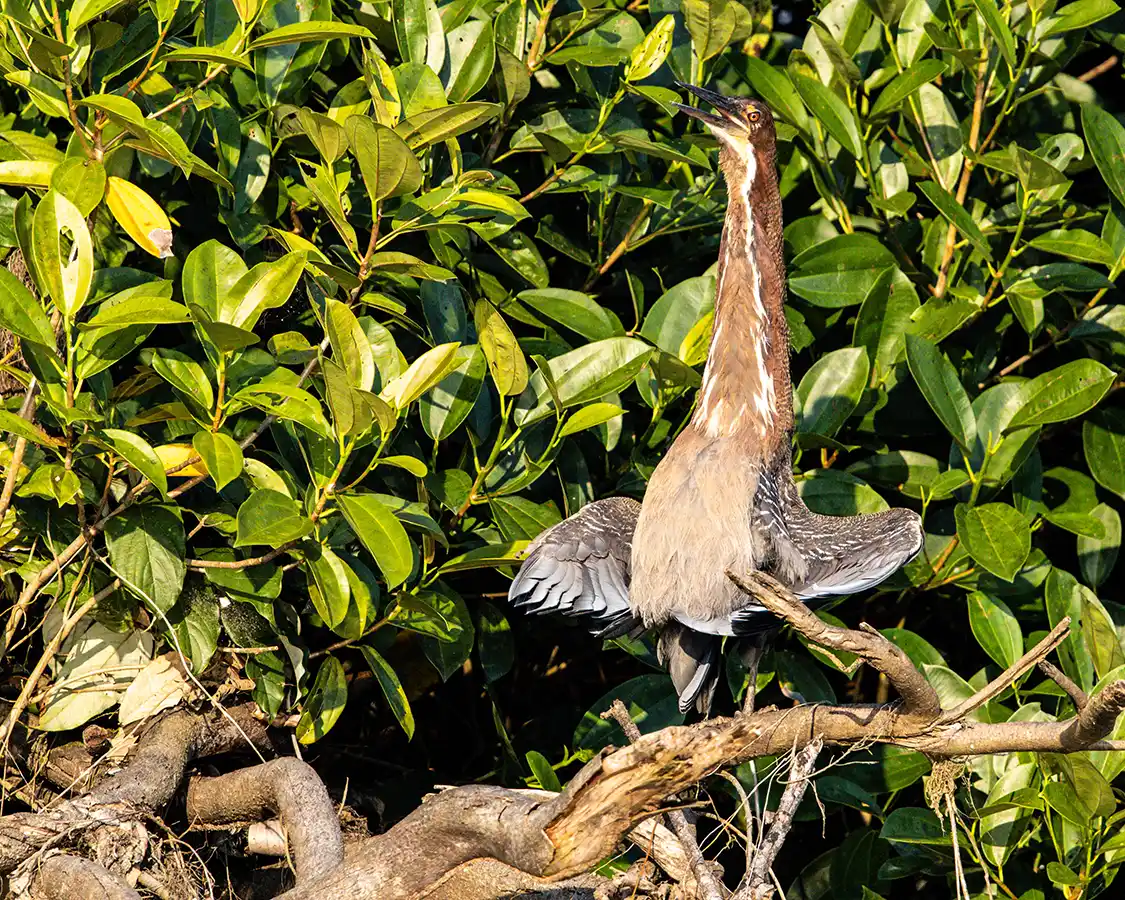
For us, the best way to understand the Amazon was from the water. Each day, we’d climb into the long, narrow canoes and paddle through flooded channels deep into the jungle. The boys took turns spotting wildlife, although Cohen, with his eagle eyes, always seemed to find the most hidden ones — monkeys leaping through the treetops, bats tucked under half-submerged branches, and herons frozen in the hunt, waiting for their moment to grab a juicy fish.
The water was the color of a Canadian double-double, and barely seemed to move. As we paddled the narrow channel, each bend revealed something new: a family of capuchins squabbling over fruit, an electric-blue butterfly the size of my hand, or a caiman gliding just below the surface. The biggest surprise was a sloth, slow and lazy, hanging just above our heads.
At night, we would head back out on the water, our flashlights scanning the darkness in search of the bright reflection of caiman eyes. Dozens of them stared back at us from the darkness. The jungle didn’t sleep; it just shifted gears.
The Observation Tower


On the second morning at the lodge, we trekked about twenty minutes through the forest to reach La Selva’s observation tower — a 125-foot structure built around an ancient kapok tree. As the forest floor sank away beneath us, the jungle canopy opened up before our eyes.
It was a different world up here. A place where birds ruled the rainforest. All around us were toucans, eagles, parrots, and the adorable blue, black, and green Paradise Tanager.
All of this beauty wasn’t without its risk, though. Dylan, resting his arms on the railing while looking at some wildlife through his binoculars, quickly jolted his hand back as a bullet ant, a creature with one of the most painful bites in the forest, skittered past his fingers.
Jungle Hikes and Night Walks
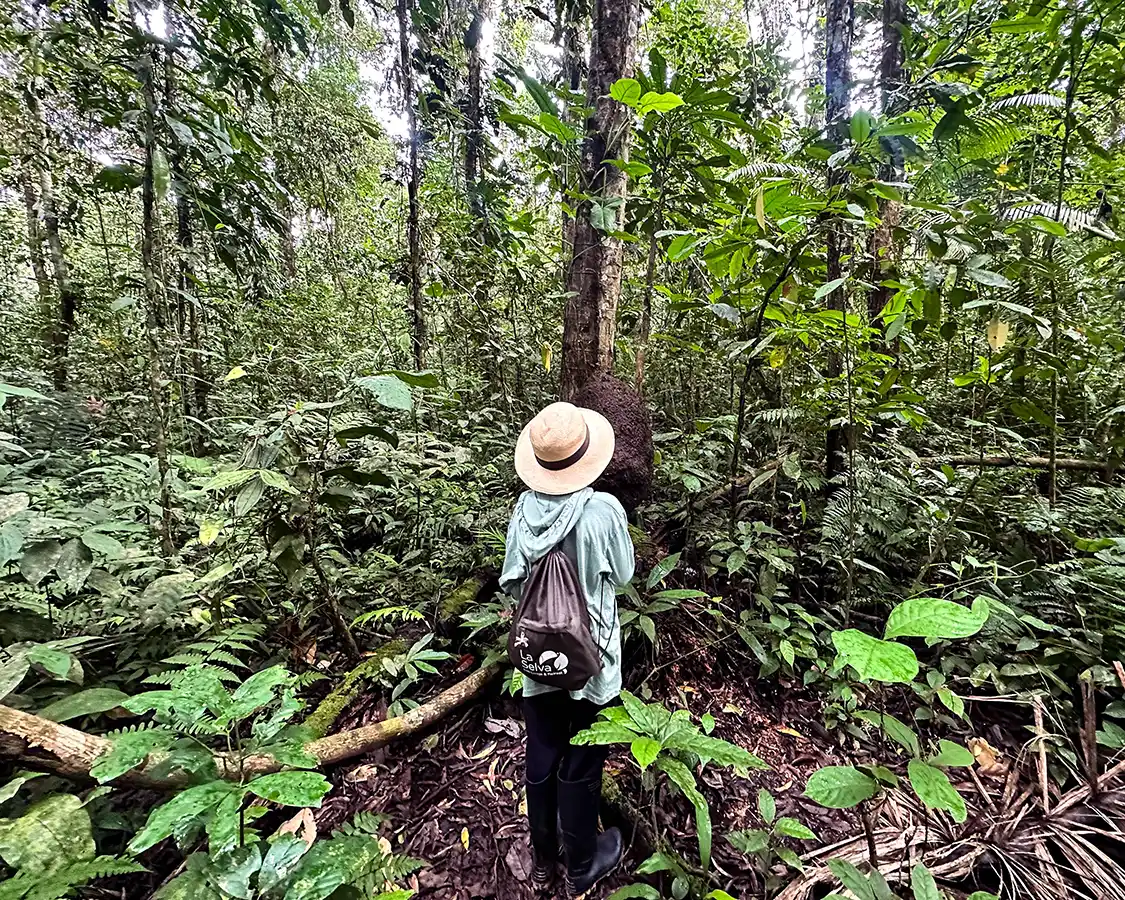

We hiked most early evenings, following narrow trails that wound through the forest like the vines of strangler figs slowly enveloping their host tree. Miguel knew every plant by name and purpose — which cured headaches, which numbed pain, and which would make you wish you’d stayed in the canoe.
We saw poison dart frogs no bigger than a fingernail, tree roots that looked like sculptures, and spiders that seemed to have missed the memo on personal space. Somewhere on the Charapa Trail, Miguel stopped and placed his hand on a massive mahogany tree, explaining it was one of the few last of its kind in the world, a tree bound for a slow extinction due to over-harvesting.
At night, we went out again, headlamps cutting through the thick darkness. The forest came alive in ways that daylight hides — frogs calling, insects chirping, the faint rustle of pygmy marmosets hiding in holes high above the ground.
Visiting the Pilche Indigenous Community


The La Selva Eco Lodge exists on the land of the Pilche community. On our third morning in the rainforest, we traveled downriver to visit them. It wasn’t a show or a setup — it was real life. We watched as women cooked over open fires, kids played soccer barefoot, and elders shared stories through our guide’s translation.
We each took turns aiming a blowdart at a wooden target. Finding out very quickly why this was the preferred hunting method of the local Indigenous People. The accuracy and power were shocking. Lunch was simple: grilled fish wrapped in leaves, cassava bread, and plantains roasted to perfection. It wasn’t fancy, but it was as authentic as it gets.
The Parrot Clay Licks
If you’ve ever seen those nature documentaries where hundreds of parrots swarm over a clay cliff, that was our next stop. We took a longboat upriver to one of the parrot clay licks inside Yasuní National Park. The reality was less BBC, more waiting game.
We joined a handful of other boats, all jockeying for position, cameras pointed at the same small patch of mud. A few green parakeets fluttered down, but the show never really started. Even the few who did arrive were so far away that even my 500 mm lens could barely capture them.
Even so, watching those bursts of color against the red clay was worth the trip — just not quite the spectacle the postcards promise.
Piranha Fishing

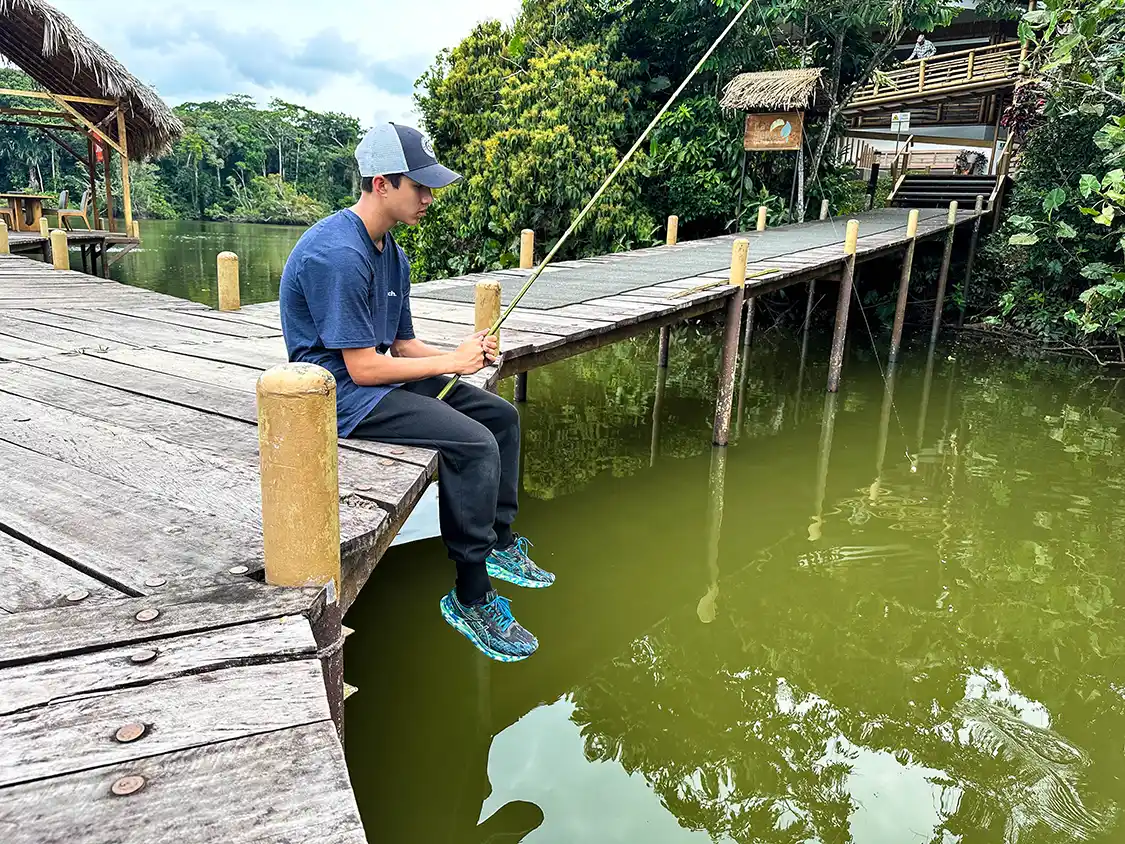
Throughout our trip, we embarked on an activity much closer to the lodge. Something Cohen had been looking forward to since we arrived — piranha fishing. Armed with bamboo rods and raw meat for bait, we dropped our lines into the murky water. Within minutes, Dylan landed one, grinning ear to ear. I caught a small one soon after. Christina came up third, netting two back-to-back.
Cohen, our self-declared family fisherman, went two hours without a single bite. His frustration hit peak levels when an older guest named Joe ambled over, cast his line once, and pulled up a fat piranha in under a minute. Joe smiled for a photo, tossed it back, and walked away. Cohen just stared at the water, defeated.
Still, that’s the Amazon — unpredictable, humbling, and occasionally hilarious.
More Activities at La Selva Lodge
Three days at La Selva Lodge gave us just a glimpse of what life in the Ecuadorian Amazon has to offer. With more time, there are even more ways for families to experience this remarkable region.
Birdwatching
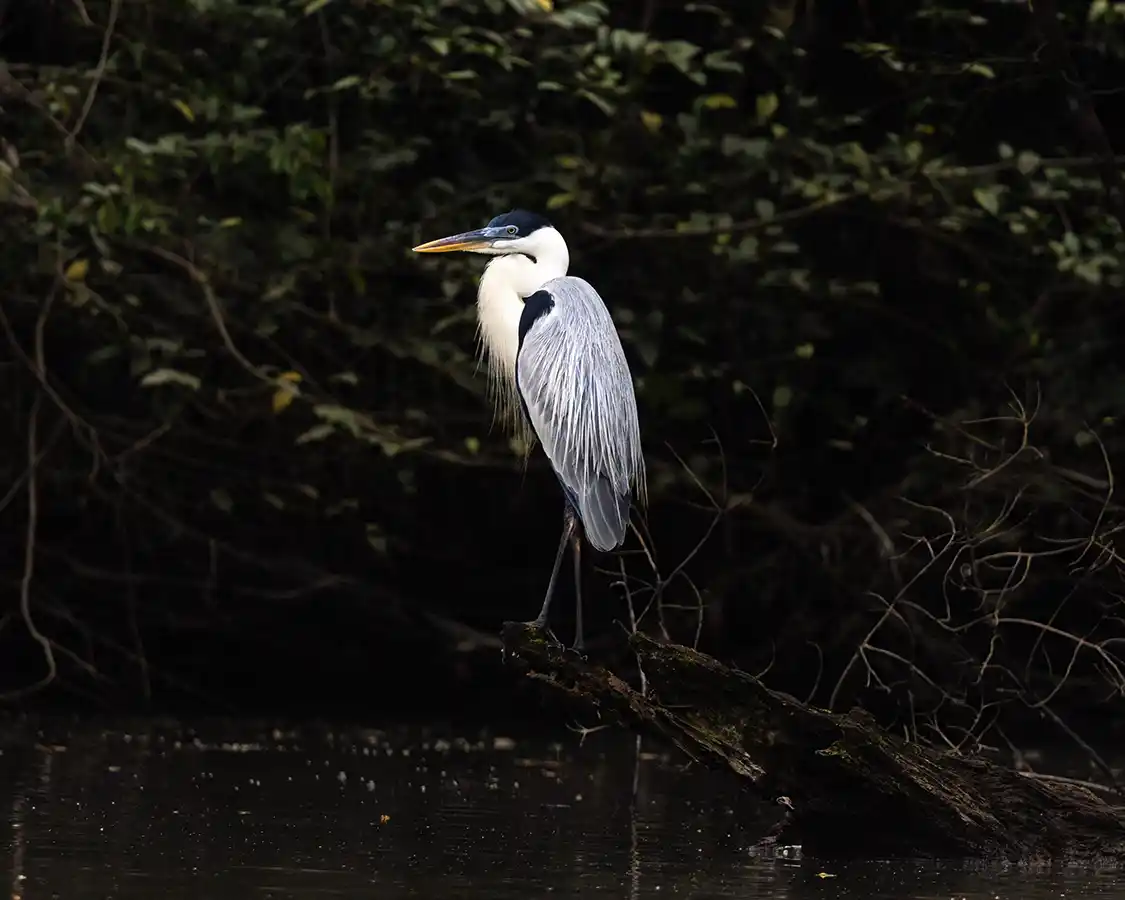
La Selva sits in one of the most biodiverse birding regions in South America. More than 600 species have been recorded in the surrounding rainforest, and the lodge is known for its early morning birdwatching excursions. Expert naturalist guides lead guests through the trails and along the lagoon to spot everything from toucans and tanagers to rare species like the crested owl and the blue-crowned motmot.
Spa and Wellness
After long days in the heat and humidity, La Selva’s small spa offers a little luxury in the middle of the wilderness. Guests can unwind with a massage or simply relax in the open-air lounge overlooking the lagoon while listening to the jungle around them.
Butterfly Farm
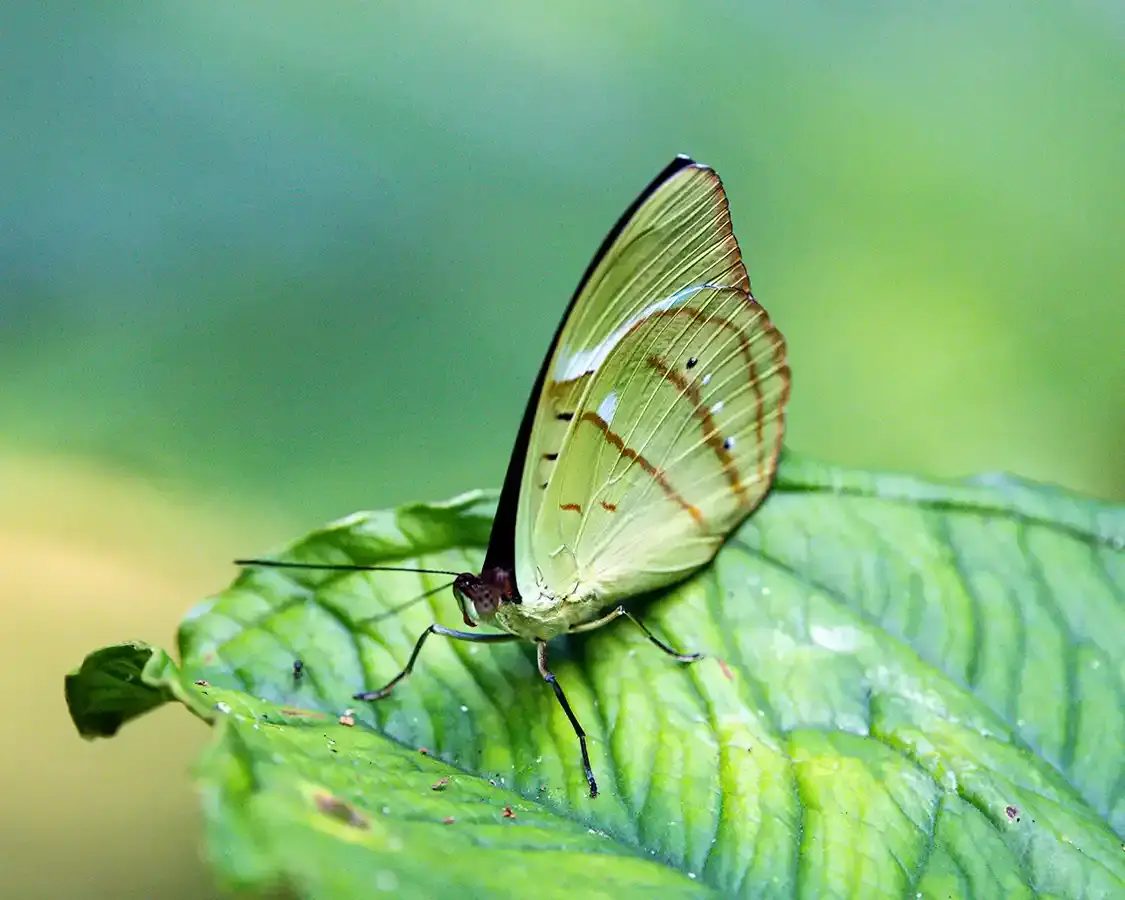
The lodge also operates a small butterfly breeding center focused on conservation and education. Guests can watch the process of metamorphosis up close and learn about the species native to this part of the Amazon. It’s especially popular with families and kids interested in the ecology of the rainforest.
These experiences, combined with the guided excursions, make La Selva one of the most well-rounded eco-lodges in the Ecuadorian Amazon. Even after our three days, it felt like we’d only scratched the surface. The deeper you go into the forest, the more it gives back — as long as you take the time to listen.
Ecuadorian Amazon Tours For Those Not Staying At a Lodge
If you’re looking to experience the Ecuadorian Amazon, but you haven’t managed to book a stay at La Selva Lodge or one of the other excellent eco-lodges in the region, you’re not out of luck. There are plenty of tours that leave directly from Coca and allow visitors to experience the rainforest from an urban home base.
🌿 Plan Your Amazon Rainforest Adventure
Ready to experience the magic of the Ecuadorian Amazon? These hand-picked tours make it easy to explore the rainforest, discover Indigenous culture, and connect with one of the most biodiverse places on Earth.
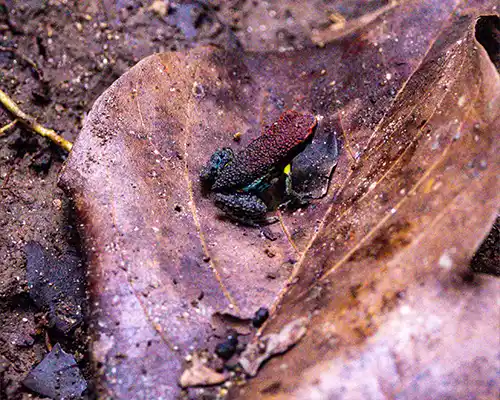
🦜 Yasuní National Park Day Tour
Explore one of the most biodiverse regions on Earth with guided jungle hikes, canoe rides, and wildlife viewing near the Napo River.
Book on Viator →
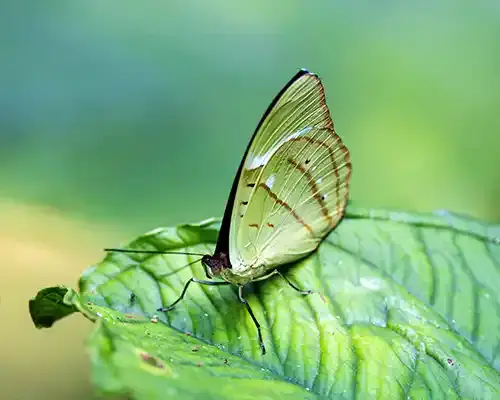
🛶 1-Day Amazon Adventure Tour from Coca
Travel deep into the rainforest, spot wildlife on the Rio Napo, and experience the region’s natural beauty with local guides.
Book on Get Your Guide →
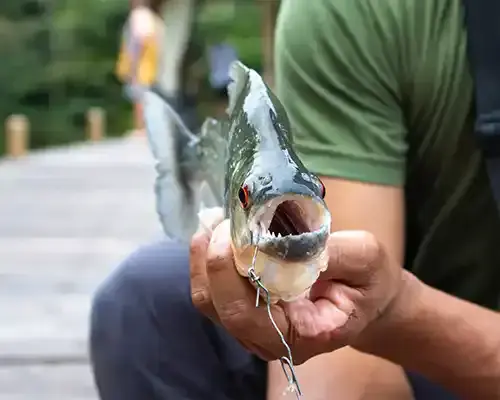
🐍 Rio Napo Cultural & Wildlife Tour
Visit local Indigenous communities, learn traditional cooking, and spot monkeys, caiman, and macaws along the Rio Napo.
Book on GetYourGuide →
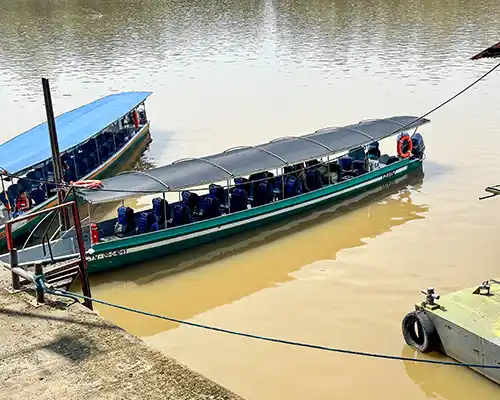
🌴 3-Day Ecuadorian Amazon Experience
Immerse yourself in the Amazon with multi-day jungle hikes, river cruises, and eco-lodge stays near Yasuní National Park and Limoncocha.
Book on Viator →
*These are affiliate links, which may earn us a small commission at no extra cost to you. Your support helps us keep sharing family travel stories and guides like this one!*
Book Your Own Stay At La Selva Eco Lodge
If this trip has inspired you to book your own family trip to the Ecuadorian Amazon, I’m stoked for you. This is truly a life-changing destination, and you’ll come back with more stories and memories than you can count. Here are a couple of options to book your own stay at La Selva Eco Lodge.
🌴 Stay at La Selva Lodge in the Ecuadorian Amazon
We booked our stay at La Selva Lodge directly, but it’s also available on major travel sites if you prefer to book through your favorite platform.

🌿 La Selva Lodge, Garzacocha Lagoon
One of Ecuador’s most renowned eco-lodges — family-friendly, sustainable, and beautifully set deep in the Amazon rainforest.
Check prices on Booking.com →

🌎 La Selva Eco Lodge on Expedia
Book your stay with flexible cancellation and reviews from verified travelers.
View on Expedia →
*We booked directly, but these links help support our site at no extra cost to you. Thank you for supporting family adventure travel!*
Tips for Visiting the Ecuadorian Amazon with Kids
Traveling to the Ecuadorian Amazon with kids isn’t exactly a beach vacation. It’s hot, it’s humid, and at some point, someone will probably find a bug in their shoe. But that’s part of the fun. The Amazon is one of the few places left on Earth that can still make you feel small, and sharing that feeling with your kids is something they’ll never forget.
Here’s what we learned from our time at La Selva Lodge and a few tips that can make your own Amazon adventure a lot smoother.
Pack Light, But Pack Smart
You won’t need much, but what you bring matters. Stick to lightweight, quick-dry, natural-colored clothing, long sleeves, and pants that can handle both sun and mosquitoes. A good rain jacket is essential, and so are sturdy sandals or hiking shoes. Don’t forget sunscreen, bug spray with DEET, and a hat. Everything you pack will be touched by humidity, so leave your fancy clothes and heavy gear behind.
Prepare for the Journey
Getting to the Amazon isn’t hard, but it takes time. From Quito, it’s a short flight to Coca, then a few hours by motorized canoe and paddleboat to reach most lodges. It’s part of the adventure, but it’s worth letting kids know in advance that this isn’t a quick transfer. Bring snacks, water, and a dry bag for electronics. The boat rides are long, but the scenery makes up for it.
Stay Flexible
The Amazon doesn’t run on schedules. Weather shifts fast, wildlife doesn’t perform on cue, and the humidity can drain the best-laid plans. Go in with a sense of humor and flexibility. The more relaxed you are, the more you’ll enjoy it. And when things don’t go as planned (they won’t), you’ll have better stories to tell later.
Health and Safety
Before traveling, talk to your doctor about vaccines and medications. Most families visiting this part of Ecuador choose to take malaria prophylaxis, though the risk is relatively low around La Selva. Bring a small first-aid kit with basics for stomach issues, motion sickness, and insect bites. The lodge staff are pros at keeping guests safe, and you’ll be surprised at how smoothly things run once you’re there.
When to Visit
The Ecuadorian Amazon is a year-round destination, but what you experience depends on the season.
- December to May is wetter and better for canoeing and birdwatching.
- June to November is drier, with easier hiking and slightly fewer mosquitoes.
We visited during the wet season and found that the extra rain made the forest feel even more alive.
Involve the Kids
Before your trip, get your kids excited about what they’ll see. Watch nature documentaries, read about rainforest animals, or look up Indigenous traditions of the Amazon. Once you arrive, let them take photos, record sounds, or keep a journal. It’s the best way to turn the trip into something they’ll take ownership of rather than just being along for the ride.
Embrace the Uncomfortable
You’re going to sweat. A lot. You’ll get rained on, and you’ll probably step in something questionable. But that’s part of what makes it great. The Amazon pushes you out of your comfort zone and reminds you that adventure isn’t supposed to be clean or predictable. And when you’re sitting back at the lodge at the end of the day, watching the last light fade over the lagoon, none of that will matter. You’ll just be grateful you came.
The Amazon Rainforest Should Be on Every Adventure-Loving Family’s Bucket List
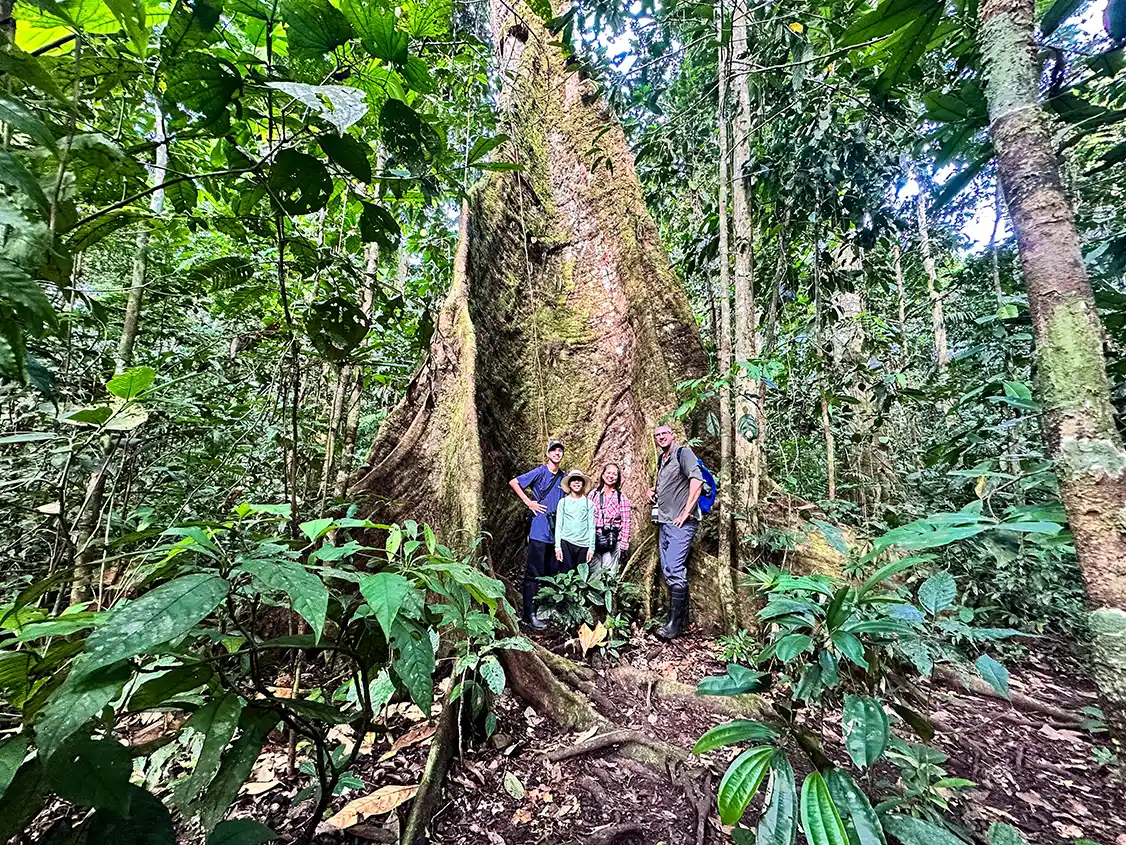
When we first planned our trip to Ecuador, the Amazon was the wild card. We’d already spent time in the Andes, explored the markets of Otavalo, hiked through Cotopaxi National Park, and sailed through the Galápagos Islands. Adding the rainforest at the end felt ambitious, maybe even unnecessary. But it turned out to be the part of the trip that changed us the most.
If you’re ready to plan your own family adventure in the Amazon, La Selva Lodge is one of the most accessible and rewarding ways to experience it. You can check availability on Booking.com or Expedia
The Ecuadorian Amazon isn’t easy. It’s hot, muddy, and sometimes chaotic. But it’s also one of the most powerful places you can share with your kids. It teaches patience, resilience, and curiosity in a way that few destinations can. It strips away comfort and distraction until what’s left is connection — to each other, to nature, and to the sheer wonder of being alive on a planet that still has wild corners.
At La Selva Lodge, we didn’t just see the rainforest. We felt it. The humidity clinging to our skin, the calls of unseen animals echoing through the night, the way the world glowed green after every rainstorm. It’s impossible to come here and not feel small — but that’s the point.
Family travel is often about showing your children the world. The Amazon flips that idea around. It shows you something instead. It reminds you how fragile life is, how much we take for granted, and how important it is to protect places like this — not just for the animals that live here, but for the lessons they still have to teach us.
When our canoe pulled away from the dock on that final morning, the mist rose off the lagoon like smoke, and the jungle seemed to breathe us out. Cohen and Dylan sat quietly, watching the trees fade into the distance. No one said a word. We didn’t need to.
The Amazon had done what it always does. It had reminded us that adventure isn’t about ticking off destinations. It’s about finding perspective.
And for that, there’s no classroom in the world quite like this one.
You May Also Like To Read:


